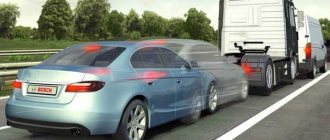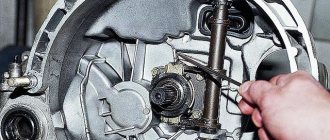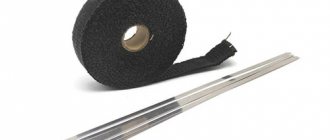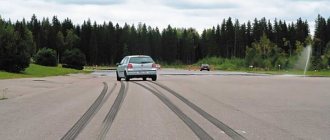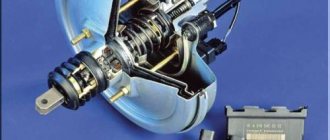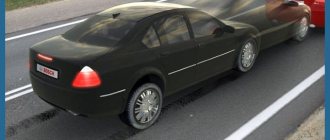Regenerative braking - what is it and how does it work?
Friends, you have probably noticed that in recent years the topic of all kinds of renewable and environmentally friendly energy sources has been discussed very actively.
In this regard, I would like to talk about a system that simply works wonders - the regenerative braking system.
First of all, I would like to say that this newfangled system has finally reached our favorite cars. Now almost every automaker has in its arsenal a couple of models with a hybrid power plant, or even an electric car altogether.
Regenerative braking is a source of energy
What is the essence of this technology? It turns out that while driving, our cars not only absorb energy by eating fuel, but also emit it.
This happens, as a rule, during braking, when a mass of kinetic energy evaporates in the form of heat from the brake mechanisms into the air, engineers once thought.
The result of their work was a regenerative braking system, that is, one that returns part of the released energy back to the car’s body, where it is then used again, which means that we save.
The easiest way to implement this trick is on hybrid cars and electric vehicles. Why? The answer will follow.
By the way, road transport is not the only place where recovery systems can be found. They have been used quite actively and for a long time on the railway by electric locomotives, as well as on urban electric transport - trams and subways.
Using a recuperation system in a suspension mechanism
Naturally, any designer always wants to get the maximum benefit from everything, so rational engineers went even further: they decided to use the kinetic energy of the suspension operating during normal driving. Levant Power and ZF are developing such a system, so that in the future, all mass-produced cars can be equipped with such devices.
How does regenerative suspension work?
The system includes a small electric motor, four electro-hydraulic pumps and a control unit. The equipment is mounted near each shock absorber, and when the rod moves in them, kinetic energy will be converted into electrical energy and supplied to the battery. The combination of this system with traditional recovery should provide approximately 2 times greater efficiency.
Conclusion
Regenerative braking is one of the most useful inventions! Indeed, why waste energy if it can be used usefully. Electric trains have the greatest benefit from recovery - that’s where the real global scale is (by the way, this is where it all started), and the smallest benefit is light individual electric transport: motorcycles, scooters, bicycles, scooters, etc. Also, the terrain plays a big role, according to which the vehicle will move. For example, in the city, it is foolish to expect great success from recovery, because there, cars crawl at a snail’s pace and drivers do not often resort to intensive deceleration. But on the hilly terrain, you can really “take a walk.” In any case, you will get some amount of energy back - sometimes more, sometimes less. Therefore, this system has every right to exist!
How to save braking energy?
It seems that we have figured out the essence of recovery, now it remains to find out how it is implemented in practice. There are several ways to channel the energy released during braking in the right direction. I only know two:
- electric;
- mechanical.
Electrical method
Electric regenerative braking, from a technological point of view, can be called the most affordable, and it is it that most closely fits the definition of this system.
Regenerative braking system
The electric method is relevant for cars with hybrid engines (ICE + electric drive) or for electric vehicles.
The main role here is played by electric motors, which, thanks to their properties, can not only spin the wheels, but also spin themselves under the influence of external forces, turning into generators.
At the moment of regenerative braking, the electric motor switches to generator mode and creates additional stopping force on the axles. In this case, it no longer consumes battery energy, but, on the contrary, recharges it, and this is repeated every time you press the brake.
Thus, according to automakers’ calculations, such a recuperation system on a hybrid car saves up to 30% of fuel reserves.
It should be noted that depending on the speed of the car, the electronics itself choose how best to brake - using an electric motor or traditional methods.
//www.youtube.com/watch?v=yfo6U3bUISM
What is recovery?
“Recuperatio” - it is from this Latin word that “recuperation” comes. Its meaning is “receiving back.” More specifically, it means returning some amount of energy or matter for further use in the same process. In the case of vehicles, we are talking about the transformation of kinetic energy into electrical energy during the braking process.
A moving car is kinetic energy, and when the braking system is applied, it needs to go somewhere. In cars, braking mechanisms rely on friction, which will generate heat as the vehicle slows down. What follows from this? And the fact that it simply disappears into nowhere—dissolves without a trace in the environment.
Savvy engineers resorted to a trick: they decided to use the free energy in a rational way and ensured that some of it would be returned. The next time the car accelerates, the battery will use the energy previously saved from recovery.
It is important to understand here that regeneration is not some kind of magic that increases the range of a vehicle on a single charge. This system won't make your car more efficient per se, it just makes it less inefficient. Essentially speaking, the ideal driving would be one in which you accelerate to a certain constant speed limit and maintain it without resorting to braking along the way.
The fact is that to slow down and then return to the previous driving pace, additional energy consumption will be required, so in order to count on a large power reserve, you need to completely avoid slowing down. Obviously, bringing such an idea to life is not realistic. In practice, you have to resort to deceleration quite often, and recuperation just makes the braking process less useless.
Home / Train driving technologies
Electrodynamic braking
Electric machines have the unique property of reversibility, i.e. under some conditions they can work as an electric motor, and under others as a generator of electrical energy. Traction motors of electric and diesel locomotives also have this property.
Application of electrodynamic braking (EDB)
Electrodynamic braking is a mode when the kinetic energy of a train is converted into electrical energy and then transferred to other consumers during regenerative braking or extinguished by braking resistors during rheostatic braking.
Regenerative braking is possible only on electric locomotives, while the generated energy is returned to the contact network, where it can be consumed by other electric locomotives following in traction mode, and in their absence, returned to the electrical network of the country's energy system. There are locomotives with a regenerative braking function, both for direct current and alternating current. Rheostatic braking is used mainly on diesel locomotives, as well as on some series of electric locomotives (VL-80t, ChS-4t). With this type of braking, the electrical energy generated by the traction motors is spent on special braking resistors, where it is converted into thermal energy.
The need to use electrodynamic braking
The use of electrodynamic braking is advisable from many points of view. Its use makes it possible to increase the safety of train traffic - since when using EDT, pneumatic brakes are not used, the train braking system is always ready for use. In this regard, there is no danger of following a prohibitory traffic light with a depleted, uncharged brake line.
The use of electrodynamic braking allows you to increase the speed of movement. So, when using pneumatic braking, the speed of movement first increases to the maximum, and then when braking it must be significantly reduced in order to have time to charge the brake system before the speed increases again to the maximum. Thus, the average speed of movement will be significantly lower than the permissible speed of movement in this area, especially in areas with large slopes. With electrodynamic braking, you can drive at a speed as close as possible to the permissible speed for a long time. It is also necessary to note the possibility of exiting from the descent to the platform or to the ascent at the maximum permissible speed. This is more difficult to achieve using air brakes. In addition, the use of regenerative braking can significantly reduce the consumption of electrical energy spent on moving the train along the site. A particularly significant decrease occurs in areas with a mountainous profile where there are “harmful slopes.”
How to use regenerative braking
When accepting the locomotive, you must ensure that the electrical regenerative braking circuit is in good working order. The operation of the exciters is checked, the smoothness of the increase in the excitation current with increasing positions. Operation of the electric blocking valve and replacement valve. The electric blocking valve prevents the locomotive brake cylinders from being filled from the air distributor when the recovery circuit is assembled. This is necessary to prevent wheel pairs from skidding, since regenerative braking creates a large braking force and if you add the braking force of the brake pads to it, then in total they can become greater than the adhesion force of the wheel to the rail. The electric blocking valve, as a rule, is supplemented by another pneumoelectric sensor that controls the pressure in the TC created by the auxiliary brake valve. Since it is impossible to exclude the effect of the locomotive's auxiliary brake in the regenerative braking mode, to prevent skidding of the wheelsets, the pressure in the TC is limited to 1.2-1.5 Atm. When this value is exceeded, the regenerative braking circuit is automatically analyzed. The replacement valve plays a protective role to prevent the train from bursting in the event of a sudden shutdown of the recovery circuit. Since during regenerative braking the entire braking force is concentrated on the locomotive and its greatest value is applied between the locomotive and the first car, the damper devices of the first cars have the greatest compression. If the regenerative braking suddenly turns off, the compressed springs are sharply released and the locomotive receives significant acceleration. Given its significant mass, this jerk can lead to breakage of the automatic coupler. To eliminate these cases, a replacement valve is installed on electric locomotives - if recovery fails, it automatically, without the participation of the driver, fills the brake cylinders to a pressure of 1.5 2 atm. After analyzing the regenerative braking circuit, the action of this valve stops.
When driving along a site, it is necessary to determine in advance the places where regenerative braking will be applied and the speed at which it will be applied. In any case, the following speed in EDT mode should be 5-10 km/h lower than permissible. This requirement is necessary for traffic safety reasons. Thus, if regenerative braking fails, the driver needs some time to analyze the recuperation scheme and apply the train’s automatic brakes. Since the automatic brakes operate with a delay, during this time the speed can increase significantly and exceed the permitted limit.
When following a descent, the collection of the recuperation scheme must begin 5-10 km/h lower than necessary for a long journey. To do this, you first need to compress the head part of the train, for which the brake cylinders are filled to a pressure of 0.5-1.0 Atm using the auxiliary brake valve. The motor-generators (exciters) are started, and the connection of the traction motors corresponding to the planned speed is established using a selective handle. By gradually increasing the TED excitation current, the appearance of the braking current is controlled. After the braking current appears, it is necessary to wait a few seconds for a more complete compression of the train, after which, releasing the brakes of the locomotive, increase the braking force by increasing the recuperation current. It is not allowed to quickly increase the braking force, as this can lead to the tail of the train running up and causing significant longitudinal dynamic reactions. If the speed is lower than necessary, then the current strength is set slightly lower than necessary for steady motion. As the speed increases, the motor current, and therefore the braking force, will increase, which will subsequently lead to stabilization of the speed. When further moving downhill, it is necessary to monitor changes in the contact line voltage and, if necessary, adjust the braking current. If there are sections of varying steepness on a descent, it is necessary to adjust the braking current to maintain a stable speed. So, if there is a flatter section ahead, it is necessary to reduce the braking force, and after following it and reaching a steeper slope again, increase it. Changes should occur smoothly with a shutter speed of several seconds at each position. If the flat section is long enough, then the braking current can be reduced in advance. This will allow you to increase your speed in front of the flat section and prevent significant deceleration there.
If it is necessary to stop regenerative braking, the braking current gradually decreases, this allows the damper devices of the head cars to “unclench”. After the armature current has been reduced to 50-150 A, the brake cylinders are filled with the auxiliary brake valve to a pressure of 0.8-1.0 Atm, after which the regenerative braking is turned off. After the effect of regenerative braking has stopped, increase the pressure in the TC to 1.5-2.0 Atm and after holding for 10-15 seconds, smoothly, in steps, release the auxiliary brake. The motor-generator is turned off, if the traction mode is then required, then the corresponding switches are made, but if it is planned to use the regenerative mode again, then the switches do not need to be made. It is better to turn off the EDT mode in such a way that at the end of the descent and transition to an incline or platform, the train reaches its maximum permissible speed. This method allows a significant part of the lift to be carried out on freewheel or with reduced currents, which will reduce power consumption and protect the traction motor from overheating.
Advantages and disadvantages of types of EDT
For all types of EDT, the disadvantage is that when following a descent, the traction electric motors are in operation, and therefore their temperature does not decrease, or decreases slowly, and when traveling with a current higher than hourly, it increases. Therefore, if there is a rise behind the descent, then overheating of the electric motor may occur on it. The occurrence of this situation is of course unlikely, but, nevertheless, when driving heavy trains on long ascents and descents, this circumstance must be taken into account. Another disadvantage is that with EDT, under the influence of the armature reaction, the location of the physical neutral changes significantly. In this case, switching in the commutator-brush assembly occurs at a point with a non-zero potential, which leads to increased sparking, the danger of a circular fire along the commutator, and increased wear of the brushes and commutator. In modern engines, compensation windings are installed, which somewhat reduce this disadvantage.
Rheostatic braking
The advantages of rheostatic braking include a relatively simple circuit; the braking characteristics do not depend on external factors (contact voltage fluctuations). AC electric locomotives do not require complex DC to AC conversion. The use of rheostatic braking is possible until the train comes to a complete stop.
The disadvantages of this type include limited power, which is determined by the dissipation power of the braking resistors, as well as the need to use cooling fans for them.
Regenerative braking
One of the main advantages of regenerative braking is the return of electrical energy and the reduction of its total consumption for traction of trains. The second is that regenerative braking is more powerful compared to rheostatic braking; in this case, it is limited by the power of the traction motors and the presence of consumers. The advantages also include automatic braking performance. With the correct connection and position, the selected speed is automatically maintained (relatively small changes) when the path profile changes. So, if for some reason there is a decrease in speed, then in response to this the regeneration current decreases and, as a result, the slowing force decreases. Thus, the speed stops decreasing and stabilizes at a new level. As the speed increases, the recuperation current, on the contrary, increases, and with it the retarding force, which also leads to its stabilization.
The disadvantages of regenerative braking include a more complex operation scheme of the electric motor and the dependence of the braking characteristics on the voltage in the contact network. The output power in regenerative mode, and even the very possibility of its use, also depends on it. Since for the regeneration effect to occur, the voltage generated by the electric motor must exceed the voltage in the contact network, then when the voltage in it is increased, the use of regenerative braking becomes impossible. Another disadvantage is the impossibility of using regenerative braking at low speeds, since even series-connected electric motors do not generate sufficient voltage for the regenerative effect to occur. It is also necessary to note the factor when, with a significant change in the voltage of the contact network, the regeneration current and, accordingly, the braking force of the electric locomotive changes. If such situations arise, the driver must adjust the regeneration current himself. In the 80s of the twentieth century, work was carried out to improve the operation of the regenerative braking circuit. Thus, the automatic control system for regenerative braking (SAURT) was used for the first time on electric locomotives VL-11. This system stabilized the armature current of the electric motor regardless of changes in voltage in the contact network or movement speed. However, in this form the effect of automatic braking characteristics disappeared. So, for example, when the speed decreased, the voltage generated by the electric motor decreased, and as a consequence, the armature current decreased. The SAURT system, in order to maintain the armature current at a given level, produced an increase in the excitation current, thus, when the speed decreased, the armature current remained constant, and the excitation current increased, which led to an increase in the retarding force and to an even greater decrease in speed. With this system, there is no longer a need to control the regeneration current during voltage fluctuations in the contact network, but there is a need to control the speed of movement and, if necessary, adjust the armature current. Nevertheless, despite the existing disadvantages, the use of regenerative braking is most desirable.
EDT on modern locomotives
Modern locomotives are equipped with microprocessor locomotive control systems, which can significantly improve the performance of electrodynamic braking. These systems can implement the functions of automatically maintaining a given speed or braking force, stabilizing the retarding force when the voltage in the contact network changes. Both types of braking are implemented on new locomotives. Thus, in the main speed range, regenerative braking is used, and at low speeds there is an automatic transition to rheostatic braking and the range of its application extends almost to a stop. It is possible to connect braking rheostats in regenerative mode. It is produced when the voltage in the contact network approaches the maximum permissible and at the same time an increase in the retarding force is required. In this situation, braking resistors consume part of the power generated by the electric locomotive, thereby allowing the decelerating effect to be maintained or enhanced. In addition, modern locomotives do not have an electrical machine converter necessary to excite traction motors. This bulky and metal-intensive unit, with complex excitation circuits, was replaced by semiconductor converters. They regulate the excitation current much more efficiently, have high performance and do not require much maintenance.
